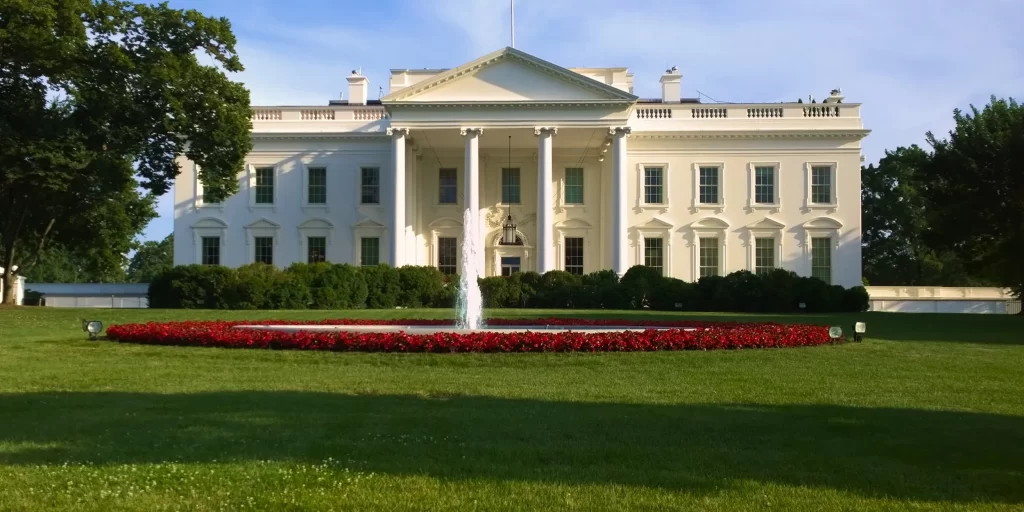The White House is a universally recognized symbol of America. It is located at 1600 Pennsylvania Avenue NW in Washington, D.C., and serves as the official residence and workplace of the President. The building reflects a nation’s history, values, and political power.
Historical Background
Construction of the White House began in 1792 and was completed by 1800. President John Adams was the first president to live there. Over the years, various individuals have renovated and added to the building. An example of neoclassical design, its exterior is symmetrical and grand. The White House has been the backdrop of much significant history for our nation, from wars to social movements.
Architectural Features
The White House is something like 55,000 sq. ft. and has six stories, including two basements. The builders primarily used white-painted Aquia Creek sandstone for the facade, giving it a distinct appearance. The North Portico has a grand entrance with giant columns, while the South Portico overlooks the Rose Garden.
The White House has 132 rooms in total on the inside. Some are the Oval Office, East Room, and State Dining Room. The entire ethos is to decorate every room with historical artifacts and artwork that reflects American culture. The decor changes based on the taste of that President, and personal flourishes throughout.
The Oval Office
The President’s central place to work is the Oval Office. This oval-shaped room with floor-to-ceiling windows has become as iconic. It includes views of the White House lawn and the Washington Monument. But expect the presidential seal, flags, and personal memorabilia instead.
The decor of the Oval Office changes with each President, reflecting their style and personality. It is an emblem of the powers and duties vested in the executive office. Prominent political figures hold meetings and press conferences in the room, which is also a location of great constitutional significance.
The West Wing
The President’s staff and closest advisors work around a central courtyard housed here for their duties. It’s called West Wing. In this section, staff and senior aides to the Chief of Staff occupy the offices. The press briefing room is also here, allowing for daily communications with journalists.
The designers structured the West Wing layout to promote collaboration and enable fast decision-making, ensuring efficiency at every step. These open right into the Oval Office, allowing easy access to a passing exchange between the President and staff. The concept promotes a sense of openness and approachability.
The East Wing
The East Wing is the office of the First Lady and her initiatives, including the First Lady’s and her staff offices. The Jacqueline Kennedy Garden offers a beautiful setting for enjoying outdoor relaxation and activities, making it a perfect spot for unwinding.
The East Wing tours and public — entrance for guests. There, visitors can learn about its historical significance and the work of First Ladies throughout history. When this division dips, it exemplifies the First Family’s place in American culture.
The Rose Garden
The courtyard beside the Oval Office, known as The Rose Garden, is a venue for official events such as press conferences and ceremonies. Flanked by roses and seasonal displays, the garden is a calm retreat.
The Rose Garden also portrays growth and rebirth. The space has been home to many significant events, including presidential announcements and U.S. diplomatic meetings. Hawks Cove is an area that speaks to the values of American culture and its relationship with nature.
The Role of the White House Today
The White House remains the heart of American political life. It is the venue for official meetings, state dinners, and public events. The President uses it to speak to the nation and make essential choices.
The White House also represents democracy and governance. It embodies the principles of freedom, equality, and justice. History buffs from all over the world flock there only to take in its artistry and former glory.
Public Access and Tours
The White House offers public tours, allowing visitors to experience its grandeur firsthand. Tours generally include significant rooms like the East Room and State Dining Room. Public site visitation is allowed, but reservations must be made in advance.
Each room tells the story of its origin and purpose. The tours feature insights into the White House and its place in American politics and culture. In principle, they seek to provide the public with access to and understanding of appreciation for our nation’s heritage.

